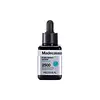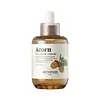What's inside
What's inside
 Key Ingredients
Key Ingredients

 Benefits
Benefits

 Concerns
Concerns

 Ingredients Side-by-side
Ingredients Side-by-side

Water
Skin ConditioningPropanediol
SolventDipropylene Glycol
HumectantNiacinamide
Smoothing1,2-Hexanediol
Skin ConditioningButyrospermum Parkii Butter
Skin ConditioningPanthenol
Skin ConditioningHydrolyzed Sponge
Skin ConditioningDiglycerin
HumectantHydroxyacetophenone
AntioxidantAmmonium Acryloyldimethyltaurate/Vp Copolymer
Glyceryl Glucoside
HumectantAcrylates/C10-30 Alkyl Acrylate Crosspolymer
Emulsion StabilisingArginine
MaskingPolyglyceryl-10 Laurate
Skin ConditioningHydrogenated Lecithin
EmulsifyingPolyglyceryl-10 Stearate
Skin ConditioningButylene Glycol
HumectantAdenosine
Skin ConditioningXanthan Gum
EmulsifyingMadecassoside
AntioxidantTrisodium Ethylenediamine Disuccinate
Pyrus Communis Fruit Extract
Skin ConditioningJuniperus Virginiana Oil
MaskingRosa Damascena Flower Water
MaskingGlucose
HumectantIris Florentina Root Extract
MaskingSimmondsia Chinensis Seed Oil
EmollientCucumis Melo Fruit Extract
Skin ConditioningPogostemon Cablin Leaf Oil
MaskingCentella Asiatica Extract
CleansingHedera Helix Leaf/Stem Extract
AntimicrobialFicus Carica Fruit Extract
HumectantCyperus Rotundus Root Extract
Skin ConditioningArtemisia Vulgaris Oil
PerfumingRosmarinus Officinalis Leaf Oil
MaskingCeramide NP
Skin ConditioningDiospyros Kaki Leaf Extract
Skin ProtectingEthylhexylglycerin
Skin ConditioningVitis Vinifera Fruit Extract
Skin ConditioningCarthamus Tinctorius Flower Extract
Skin ConditioningCoffea Arabica Seed Extract
MaskingPolygonum Cuspidatum Root Extract
AntioxidantCamellia Sinensis Leaf Extract
AntimicrobialCastanea Crenata Shell Extract
Skin ConditioningZanthoxylum Piperitum Fruit Extract
Skin ConditioningCitric Acid
BufferingWater, Propanediol, Dipropylene Glycol, Niacinamide, 1,2-Hexanediol, Butyrospermum Parkii Butter, Panthenol, Hydrolyzed Sponge, Diglycerin, Hydroxyacetophenone, Ammonium Acryloyldimethyltaurate/Vp Copolymer, Glyceryl Glucoside, Acrylates/C10-30 Alkyl Acrylate Crosspolymer, Arginine, Polyglyceryl-10 Laurate, Hydrogenated Lecithin, Polyglyceryl-10 Stearate, Butylene Glycol, Adenosine, Xanthan Gum, Madecassoside, Trisodium Ethylenediamine Disuccinate, Pyrus Communis Fruit Extract, Juniperus Virginiana Oil, Rosa Damascena Flower Water, Glucose, Iris Florentina Root Extract, Simmondsia Chinensis Seed Oil, Cucumis Melo Fruit Extract, Pogostemon Cablin Leaf Oil, Centella Asiatica Extract, Hedera Helix Leaf/Stem Extract, Ficus Carica Fruit Extract, Cyperus Rotundus Root Extract, Artemisia Vulgaris Oil, Rosmarinus Officinalis Leaf Oil, Ceramide NP, Diospyros Kaki Leaf Extract, Ethylhexylglycerin, Vitis Vinifera Fruit Extract, Carthamus Tinctorius Flower Extract, Coffea Arabica Seed Extract, Polygonum Cuspidatum Root Extract, Camellia Sinensis Leaf Extract, Castanea Crenata Shell Extract, Zanthoxylum Piperitum Fruit Extract, Citric Acid
Water
Skin ConditioningQuercus Acutissima Fruit Extract 10%
AstringentPropanediol
SolventDipropylene Glycol
HumectantButylene Glycol
HumectantGlycerin
HumectantNiacinamide
SmoothingPentylene Glycol
Skin ConditioningHamamelis Virginiana Extract
AntiseborrhoeicPolyglyceryl-10 Laurate
Skin ConditioningHydroxyacetophenone
Antioxidant1,2-Hexanediol
Skin ConditioningOpuntia Ficus-Indica Stem Extract
Skin ConditioningAcrylates/C10-30 Alkyl Acrylate Crosspolymer
Emulsion StabilisingTromethamine
BufferingDiospyros Kaki Fruit Extract
Skin ConditioningCamellia Sinensis Leaf Extract
AntimicrobialCastanea Crenata Shell Extract
Skin ConditioningGluconolactone
Skin ConditioningPanthenol
Skin ConditioningAllantoin
Skin ConditioningCarbomer
Emulsion StabilisingAdenosine
Skin ConditioningDiphenyl Dimethicone
EmollientTriethylhexanoin
MaskingSodium Phytate
Sodium Polyacryloyldimethyl Taurate
Emulsion StabilisingEnantia Chlorantha Bark Extract
Skin ConditioningSodium Hyaluronate
HumectantHydrolyzed Lupine Protein
Skin ConditioningDextrin
AbsorbentTheobroma Cacao Extract
Skin ConditioningPolyglyceryl-10 Oleate
Skin ConditioningHydrogenated Lecithin
EmulsifyingEucalyptus Globulus Leaf Oil
PerfumingRosmarinus Officinalis Leaf Oil
MaskingAmyris Balsamifera Bark Oil
MaskingBiosaccharide Gum-1
HumectantSalvia Officinalis Oil
MaskingCitrus Aurantium Bergamia Fruit Oil
MaskingPueraria Lobata Root Extract
HumectantUlmus Davidiana Root Extract
Skin ConditioningOenothera Biennis Flower/Leaf/Stem Extract
Skin ConditioningPinus Palustris Leaf Extract
TonicHelianthus Annuus Seed Oil
EmollientPalmitoyl Tripeptide-5
Skin ConditioningSalvia Sclarea Oil
MaskingEthylhexylglycerin
Skin ConditioningHydroxypropyltrimonium Hyaluronate
Oleanolic Acid
Skin ConditioningSodium Acetylated Hyaluronate
HumectantHydrolyzed Hyaluronic Acid
HumectantHyaluronic Acid
HumectantSodium Hyaluronate Crosspolymer
HumectantHydrolyzed Sodium Hyaluronate
Skin ConditioningPotassium Hyaluronate
Skin ConditioningWater, Quercus Acutissima Fruit Extract 10%, Propanediol, Dipropylene Glycol, Butylene Glycol, Glycerin, Niacinamide, Pentylene Glycol, Hamamelis Virginiana Extract, Polyglyceryl-10 Laurate, Hydroxyacetophenone, 1,2-Hexanediol, Opuntia Ficus-Indica Stem Extract, Acrylates/C10-30 Alkyl Acrylate Crosspolymer, Tromethamine, Diospyros Kaki Fruit Extract, Camellia Sinensis Leaf Extract, Castanea Crenata Shell Extract, Gluconolactone, Panthenol, Allantoin, Carbomer, Adenosine, Diphenyl Dimethicone, Triethylhexanoin, Sodium Phytate, Sodium Polyacryloyldimethyl Taurate, Enantia Chlorantha Bark Extract, Sodium Hyaluronate, Hydrolyzed Lupine Protein, Dextrin, Theobroma Cacao Extract, Polyglyceryl-10 Oleate, Hydrogenated Lecithin, Eucalyptus Globulus Leaf Oil, Rosmarinus Officinalis Leaf Oil, Amyris Balsamifera Bark Oil, Biosaccharide Gum-1, Salvia Officinalis Oil, Citrus Aurantium Bergamia Fruit Oil, Pueraria Lobata Root Extract, Ulmus Davidiana Root Extract, Oenothera Biennis Flower/Leaf/Stem Extract, Pinus Palustris Leaf Extract, Helianthus Annuus Seed Oil, Palmitoyl Tripeptide-5, Salvia Sclarea Oil, Ethylhexylglycerin, Hydroxypropyltrimonium Hyaluronate, Oleanolic Acid, Sodium Acetylated Hyaluronate, Hydrolyzed Hyaluronic Acid, Hyaluronic Acid, Sodium Hyaluronate Crosspolymer, Hydrolyzed Sodium Hyaluronate, Potassium Hyaluronate
Ingredients Explained
These ingredients are found in both products.
Ingredients higher up in an ingredient list are typically present in a larger amount.
1,2-Hexanediol is a synthetic liquid and another multi-functional powerhouse.
It is a:
- Humectant, drawing moisture into the skin
- Emollient, helping to soften skin
- Solvent, dispersing and stabilizing formulas
- Preservative booster, enhancing the antimicrobial activity of other preservatives
Acrylates/C10-30 Alkyl Acrylate Crosspolymer is a synthetic polymer. It is used to thicken and improve the texture of products. Due to its properties, it can prevent water and oil ingredients from separating.
Adenosine is in every living organism. It is one of four components in nucleic acids that helps store our DNA.
Adenosine has many benefits when used. These benefits include hydrating the skin, smoothing skin, and reducing wrinkles. Once applied, adenosine increases collagen production. It also helps with improving firmness and tissue repair.
Studies have found adenosine may also help with wound healing.
In skincare products, Adenosine is usually derived from yeast.
Learn more about AdenosineButylene Glycol (or BG) is used within cosmetic products for a few different reasons:
Overall, Butylene Glycol is a safe and well-rounded ingredient that works well with other ingredients.
Though this ingredient works well with most skin types, some people with sensitive skin may experience a reaction such as allergic rashes, closed comedones, or itchiness.
Learn more about Butylene GlycolCamellia Sinensis Leaf Extract is derived from the leaves of the tea plant. Black tea, green tea, and oolong tea are all harvested from this plant.
This ingredient has many skin benefits:
This ingredient contains polyphenols, a strong antioxidant. Antioxidants help fight off molecules that damage skin cells.
On top of that, the antioxidants in green tea neutralize free-radicals from the sun. This gives the skin some extra UV protection, but should not replace sunscreen.
Many components of tea have anti-inflammatory properties.
Polyphenols and L-theanine help soothe the skin and reduce irritation. The caffeine in Camellia Sinensis Leaf Extract helps calm inflamed blood vessels.
Other compounds found in tea include: Vitamin Bs, linoleic acid, magnesium, calcium, iron, and zinc.
Research has shown both drinking Camellia Sinensis Leaf Tea and applying it to the skin can help boost skin elasticity and hydration. Studies also show using tea extract may reduce sebum, or oil, production.
Learn more about Camellia Sinensis Leaf ExtractCastanea Crenata Shell Extract comes from the shell of the chestnut.
Studies show chestnut shells to have antioxidant and anti-inflammatory properties.
Antioxidants protect your skin against damaging molecules. This may help reduce the signs of aging.
Learn more about Castanea Crenata Shell ExtractDipropylene Glycol is a synthetically created humectant, stabilizer, and solvent.
This ingredient helps:
Dipropylene glycol is technically an alcohol, but it belongs to the glycol family (often considered part of the ‘good’ alcohols). This means it is hydrating and gentle on skin unlike drying solvent alcohols like denatured alcohol.
As a masking agent, Dipropylene Glycol can be used to cover the smell of other ingredients. However, it does not have a scent.
Studies show Dipropylene Glycol is considered safe to use in skincare.
Learn more about Dipropylene GlycolEthylhexylglycerin (we can't pronounce this either) is commonly used as a preservative and skin softener. It is derived from glyceryl.
You might see Ethylhexylglycerin often paired with other preservatives such as phenoxyethanol. Ethylhexylglycerin has been found to increase the effectiveness of these other preservatives.
Hydrogenated Lecithin is created from the hydrogenation of lecithin (a group of phospholipids). Hydrogenation is a chemical reaction between hydrogen and another element.
This ingredient is an emollient and emulsifier. As an emollient, it helps soften skin by trapping moisture within. As an emulsifier, it prevents oil and water ingredients from separating.
Hydroxyacetophenone is antioxidant with skin conditioning and soothing properties. It also boosts the efficiency of preservatives.
This ingredient is not irritating or sensitizing.
Niacinamide is a multitasking form of vitamin B3 that strengthens the skin barrier, reduces pores and dark spots, regulates oil, and improves signs of aging.
And the best part? It's gentle and well-tolerated by most skin types, including sensitive and reactive skin.
You might have heard of "niacin flush", or the reddening of skin that causes itchiness. Niacinamide has not been found to cause this.
In very rare cases, some individuals may not be able to tolerate niacinamide at all or experience an allergic reaction to it.
If you are experiencing flaking, irritation, and dryness with this ingredient, be sure to double check all your products as this ingredient can be found in all categories of skincare.
When incorporating niacinamide into your routine, look out for concentration amounts. Typically, 5% niacinamide provides benefits such as fading dark spots. However, if you have sensitive skin, it is better to begin with a smaller concentration.
When you apply niacinamide to your skin, your body converts it into nicotinamide adenine dinucleotide (NAD). NAD is an essential coenzyme that is already found in your cells as "fuel" and powers countless biological processes.
In your skin, NAD helps repair cell damage, produce new healthy cells, support collagen production, strengthen the skin barrier, and fight environmental stressors (like UV and pollution).
Our natural NAD levels start to decline with age, leading to slower skin repair, visible aging, and a weaker skin barrier. By providing your skin niacinamide, you're recharging your skin's NAD levels. This leads to stronger, healthier, and younger looking skin.
Another name for vitamin B3 is nicotinamide. This vitamin is water-soluble and our bodies don't store it. We obtain Vitamin B3 from either food or skincare. Meat, fish, wheat, yeast, and leafy greens contain vitamin B3.
The type of niacinamide used in skincare is synthetically created.
Learn more about NiacinamidePanthenol is a common ingredient that helps hydrate and soothe the skin. It is found naturally in our skin and hair.
There are two forms of panthenol: D and L.
D-panthenol is also known as dexpanthenol. Most cosmetics use dexpanthenol or a mixture of D and L-panthenol.
Panthenol is famous due to its ability to go deeper into the skin's layers. Using this ingredient has numerous pros (and no cons):
Like hyaluronic acid, panthenol is a humectant. Humectants are able to bind and hold large amounts of water to keep skin hydrated.
This ingredient works well for wound healing. It works by increasing tissue in the wound and helps close open wounds.
Once oxidized, panthenol converts to pantothenic acid. Panthothenic acid is found in all living cells.
This ingredient is also referred to as pro-vitamin B5.
Learn more about PanthenolPolyglyceryl-10 Laurate is an ester of lauric acid and Polyglycerin-10.
Polyglyceryl-10 Laurate is a cleansing agent and emulsifier. It helps gather dirt, oil, and other pollutants to be rinsed away. As an emulsifier, it helps prevent ingredients from separating, such as oil and water.
Polyglyceryl-10 Laurate may not be fungal acne safe.
Learn more about Polyglyceryl-10 LauratePropanediol is an all-star ingredient. It softens, hydrates, and smooths the skin.
It’s often used to:
Propanediol is not likely to cause sensitivity and considered safe to use. It is derived from corn or petroleum with a clear color and no scent.
Learn more about PropanediolRosmarinus Officinalis Leaf Oil is oil expressed from the leaves of the rosemary plant.
Rosemary Leaf Oil is a fragrance and helps give your product a scent. If you are sensitive to irritating fragrances, this one contains camphor. Camphor has been found to irritate skin.
This oil also contains antioxidant and antimicrobial properties. As an antioxidant, it may protect you skin against damage. This can help slow down the signs of aging.
Learn more about Rosmarinus Officinalis Leaf OilWater. It's the most common cosmetic ingredient of all. You'll usually see it at the top of ingredient lists, meaning that it makes up the largest part of the product.
So why is it so popular? Water most often acts as a solvent - this means that it helps dissolve other ingredients into the formulation.
You'll also recognize water as that liquid we all need to stay alive. If you see this, drink a glass of water. Stay hydrated!
Learn more about Water